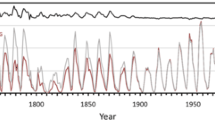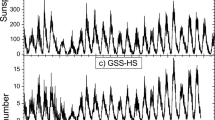Abstract
We study the first differences \(w(t)\) of the International Sunspot Number (ISSN) daily series for the time span 1850 – 2013. The one-day correlations \(\rho_{1}\) between \(w(t)\) and \(w(t+1)\) are computed within four-year sliding windows and are found to shift from negative to positive values near the end of Cycle 17 (\({\sim}\,1945\)). They remain positive during the last Grand Maximum and until \({\sim}\,2009\), when they fall to zero. We also identify a prominent regime change in \({\sim}\,1915\), strengthening previous evidence of major anomalies in solar activity at this date. We test an autoregressive process of order 1 (AR(1)) as a model that can reproduce the high-frequency component of ISSN: we compute \(\rho_{1}\) for this AR(1) process and find that it is negative. Positive values of \(\rho_{1}\) are found only if the process involves positive correlation: this leads us to suggest that the births of successive spots are positively correlated during the last Grand Maximum.




Similar content being viewed by others
References
Barnes, J.A., Sargent, H.H., Tryon, P.V.: 1980, Sunspot cycle simulation using random noise. In: Pepin, R.O., Eddy, J.A., Merrill, R.B. (eds.) The Ancient Sun: Fossil Record in the Earth, Moon and Meteorites, Pergamon, New York, 159.
Baumann, I., Solanki, S.K.: 2005, On the size distribution of sunspot groups in the Greenwich sunspot record 1874 – 1976. Astron. Astrophys. 443, 1061. DOI .
Blanter, E.M., Shnirman, M.G., Le Mouël, J.-L.: 2005, Solar variability: evolution of correlation properties. J. Atmos. Solar-Terr. Phys. 67, 521. DOI .
Blanter, E.M., Le Mouël, J.-L., Perrier, F., Shnirman, M.G.: 2006, Short-term correlation of solar activity and sunspot: evidence of lifetime increase. Solar Phys. 237, 329. DOI .
Brajša, R., Wöhl, H., Hanslmeier, A., Verbanac, J., Ruždjak, D., Cliver, E., Svalgaard, L., Roth, M.: 2009, On solar cycle predictions and reconstructions. Astron. Astrophys. 496, 855. DOI .
Charbonneau, P., Dikpati, M.: 2000, Stochastic fluctuations in a Babcock Leighton model of the solar cycle. Astrophys. J. 543, 1027. DOI .
Choudhuri, A.R.: 1992, Stochastic fluctuations of the solar dynamo. Astron. Astrophys. 253, 277. ADS .
Choudhuri, A.R., Karak, B.B.: 2012, Origin of grand minima in sunspot cycles. Phys. Rev. Lett. 109, 171103. DOI .
Crosson, I.J., Binder, P.M.: 2009, Chaos-based forecast of sunspot cycle 24. Geophys. Res. Lett. 114, A01108. DOI .
Feynman, J., Gabriel, S.B.: 1990, Period and phase of the 88-year solar cycle and the Maunder minimum: evidence for a chaotic Sun. Solar Phys. 127, 399. DOI .
Greenkorn, R.A.: 2009, Analysis of sunspot activity cycles. Solar Phys. 255, 301. DOI .
Hanslmeier, A., Brajša, R.: 2010, The chaotic solar cycle. Astron. Astrophys. 509, A5. DOI . ADS .
Harvey, K.L., Zwaan, C.: 1993, Properties and emergence of bipolar active regions. Solar Phys. 148, 85. DOI .
Hathaway, D.H., Wilson, R.M., Reichmann, E.J.: 2002, Group sunspot numbers: sunspot cycle characteristics. Solar Phys. 211, 357. DOI .
Henwood, R., Chapman, S.C., Willis, D.M.: 2010, Increasing lifetime of recurrent sunspot groups within the greenwich photoheliographic results. Solar Phys. 262, 299. DOI .
Hiremath, K.M.: 2008, Prediction of solar cycle 24 and beyond. Astrophys. Space Sci. 314, 45. DOI . ADS .
Javaraiah, J.: 2012, Solar cycle variations in the growth and decay of sunspot groups. Astrophys. Space Sci. 338, 217. DOI . ADS .
Lawrence, J.K., Cadavid, A.C., Ruzmaikin, A.A.: 1995, Turbulent and chaotic dynamics underlying solar magnetic variability. Astron. Astrophys. 455, 366. DOI . ADS .
Lawrence, J.K., Cadavid, A.C., Ruzmaikin, A.A.: 2008, Rotational quasi-periodicities and the Sun-heliosphere connection. Solar Phys. 252, 179. DOI .
Le Mouël, J.-L., Shnirman, M.G., Blanter, E.M.: 2007, The 27-day signal in sunspot number series and the solar dynamo. Solar Phys. 246, 295. DOI . ADS .
Love, J.J., Joshua Rigler, E.: 2012, Sunspot random walk and 22-year variation. Geophys. Res. Lett. 39, L10103. DOI . ADS .
Love, J.J., Joshua Rigler, E., Gibson, S.E.: 2012, Geomagnetic detection of the sectorial solar magnetic field and the historical peculiarity of minimum 23–24. Geophys. Res. Lett. 39, 322. DOI . ADS .
Ostryakov, V.N., Usoskin, I.G.: 1990, On the dimension of solar attractor. Solar Phys. 127, 405. DOI . ADS .
Petrovay, K., Martínez Pillet, V., van Driel-Gesztelyi, L.: 1999, Making sense of sunspot decay – II. Deviations from the mean law and plage effects. Solar Phys. 188, 315. DOI . ADS .
Pop, M.-I.: 2012, Distribution of the daily sunspot number variation for the last 14 solar cycles. Solar Phys. 276, 351. DOI . ADS .
Ruzmaikin, A., Feynman, J., Kosacheva, V.: 1992, On long-term dynamics of the solar cycle. In: Harvey, K.L. (ed.) The Solar Cycle; Proc. National Solar Observatory/Sacramento Peak 12th Summer Workshop, ASP Conf. Ser., San Francisco, 27, 547.
Sello, S.: 2001, Solar cycle forecasting: a nonlinear dynamics approach. Astron. Astrophys. 377, 312. DOI . ADS .
Shapoval, A., Courtillot, V., Le Mouël, J.-L., Shnirman, M.G.: 2013, Two regimes in the regularity of sunspot number. Astrophys. J. 779, 108. DOI . ADS .
Shapoval, A., Le Mouël, J.-L., Shnirman, M.G., Courtillot, V.: 2014a, Can irregularities of solar proxies help understand quasi-biennial solar variations? Nonlinear Process. Geophys. 21, 797. DOI .
Shapoval, A., Le Mouël, J.-L., Courtillot, V., Shnirman, M.G.: 2014b, Is a sudden increase of irregularity of sunspot numbers a precursor of a return to low solar activity? J. Geophys. Res. 119, 6120. DOI . ADS .
Shapoval, A., Le Mouël, J.-L., Shnirman, M.G., Courtillot, V.: 2015, Stochastic description of the high-frequency content of daily sunspots and evidence for regime changes. Astrophys. J. 799, 56. DOI . ADS .
Spiegel, E.A., Wolf, A.: 1987, Chaos and the solar cycle. In: Buchler, J.R., Eichhorn, H. (eds.) Chaotic Phenomena in Astrophysics 497, N.Y. Acad. Sci., New York, 55.
Suyal, V., Prasad, A., Singh, H.P.: 2009, Nonlinear time series analysis of sunspot data. Solar Phys. 260, 441. DOI .
Usoskin, I.G., Solanki, S.K., Kovaltsov, G.A.: 2007, Grand minima and maxima of solar activity: new observational constraint. Astron. Astrophys. 471, 301. DOI .
Van der Linden, R.A.M., SIDC team: 2014, Online catalogue of the sunspot index. http://sidc.oma.be/html/sunspot.html .
Xu, T., Wu, J., Wu, Z.-S., Li, Q.: 2008, Long-term sunspot number prediction based on EMD analysis and AR model. Chin. J. Astron. Astrophys. 8, 337. DOI . ADS .
Acknowledgements
The daily ISSN are reported by Van der Linden and SIDC team (2014), http://sidc.oma.be/html/sunspot.html . IPGP provided support to A. Shapoval and M. Shnirman during their visit to the institute. A. Shapoval was partially supported by RFBR grants 14-01-00346 and 14-01-00773. IPGP contribution NS 3689.
Author information
Authors and Affiliations
Corresponding author
Appendix: Analytical computation of correlations
Appendix: Analytical computation of correlations
For the common AR(1) process defined by Equation (2) without modulation, when the random variables \(\eta_{k}\) have a finite variance \(\mathbf{Var}(\eta_{k})=\sigma_{k}^{2}\), the auto-correlation can be calculated analytically. We set \(g(t)=G(t+1)-G(t)\). The covariance is
If the random variables \(\eta\) are independent, the terms \(\mathbf{Cov}(\eta_{i},\eta_{j})\) disappear for \(i\ne j\), and Equation (5) is simplified into
If \(\sigma_{k}=\sigma\) for all \(k\), then
Since the variance of the one-step differences is equal to
the correlation \(\rho_{1}\) between the daily differences is
From Equation (8) it follows that the one-day auto-correlation of the AR(1)-process is negative and goes to zero as the auto-correlation factor \(a\) tends to 1.
Rights and permissions
About this article
Cite this article
Shapoval, A., Le Mouël, JL., Shnirman, M. et al. When Daily Sunspot Births Become Positively Correlated. Sol Phys 290, 2709–2717 (2015). https://doi.org/10.1007/s11207-015-0778-9
Received:
Accepted:
Published:
Issue Date:
DOI: https://doi.org/10.1007/s11207-015-0778-9




